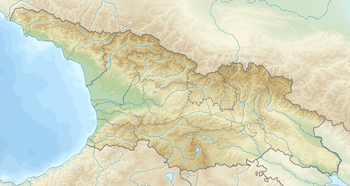Tusheti National Park
| Tusheti National Park | |
|---|---|
|
IUCN category II (national park) | |
 Tusheti National Park | |
 | |
| Location |
|
| Nearest city | Tusheti |
| Coordinates | 42°24′36″N 45°29′13″E / 42.41000°N 45.48694°ECoordinates: 42°24′36″N 45°29′13″E / 42.41000°N 45.48694°E |
| Area | 83453 ha |
| Established | 2003 |
The Tusheti National Park in East Georgia is one of the eight new Protected Areas approved by Parliament of Georgia on 22 April 2003. Global Environment Facility (GEF) and the World Bank were part of this approval process under the "Georgia – Protected Areas Development Project." Plants conserved in the park are pine groves (Pinus sosnovkji) and birch groves (Betula litvinovii, Betula raddeana). The key faunal species in the park are Anatolian leopard (Panthera pardus ambornii), bear, chamois, falcon, Golden Eagle, lammergeier, lynx, mountain goat, wild goat, and wolf.[1] The park was named one of the "12 best places you’ve never heard of" by BudgetTravel in 2011 not only for its rich biodiversity but also for its aesthetic terrain, hamlets, old defense towers, cuisine, and folk culture.[2]
Location
The park is set in the Tusheti Mountainous region in the north-eastern part of the country. It is 205 kilometres (127 mi) away from Tbilisi with the en route Alvani lying 120 kilometres (75 mi) away. Omalo-Alvani highway of 85 kilometres (53 mi) length is in a hilly terrain and is difficult to drive. The visitor center to the parks and reserves of Tusheti is located along the 85 kilometres (53 mi) of the main watershed ridge of Caucasus in lower Omalo.[3] Its ecoregion is that of the Caucasus mixed forests.[4]
Features
The park has an approved land area of 83,453 hectares (206,220 acres),[1] which lies within an elevation range of 900–4,800 metres (3,000–15,700 ft).[5] The main functions of the park administration are to provide protection and conserve the flora and fauna of the park concurrently supporting the interests of the 50 nomadic communities, and achieving conservation of the linked historic monuments; and also to encourage eco-tourism.[6]
For the endangered Wild Goat (Capra aegagrus) the park is the only intact habitat. To protect this species from poaching and enable its viewing in the park by visitors, the Centre for Biodiversity Conservation & Research (NACRES), an IUCN member, carried out a pilot project titled "viewing potential" by monitoring the "risks and benefits to conservation and the cost of setting up and operation of wildlife viewing trails." The local partners associated with this study were "Tusheti Guide" and "Friends of Tusheti Protected Areas". A wild goat monitoring scheme was established, and local guides, park rangers and local groups were trained to ensure protection to the wild goat. The project has proved successful as more visitors could view the goat now, and NACRES is continuing its support.[2]
Gallery
 Tusheti National Park
Tusheti National Park- A Ranger Station in the park
 Another view of the park
Another view of the park

























See also
References
- 1 2 "Tushetian Protected Landscape". tusheti.ge. Retrieved 23 November 2015.
- 1 2 "Wildlife viewing in Georgia's Tusheti National Park". IUCN Organization. 5 December 2012. Retrieved 23 November 2015.
- ↑ "Tusheti National Park Visitor Centre". Agency of Protected Areas. Retrieved 23 November 2015.
- ↑ "Caucasus mixed forests". Terrestrial Ecoregions. World Wildlife Fund.
- ↑ "Naturschutzgebiete & Nationalparks" (in German). Georgia Insight. Retrieved 23 November 2015.
- ↑ "Georgia: Tusheti Natural Reserve". Planet Doc TV. Retrieved 23 November 2015.